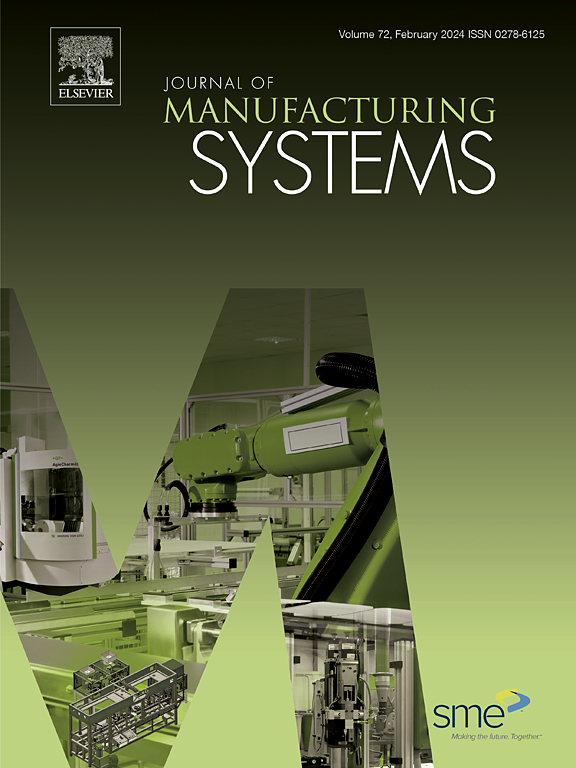A mutual cross-attention fusion network for surface roughness prediction in robotic machining process using internal and external signals
IF 14.2
1区 工程技术
Q1 ENGINEERING, INDUSTRIAL
引用次数: 0
Abstract
Compared with machine tools, industrial robots exhibit low, position-dependent stiffness. This dynamic compliance leads to inconsistent surface roughness under identical machining parameters when the robot configuration changes, thereby significantly complicating roughness prediction. Therefore, to address the challenge of predicting surface roughness in robotic machining processes and provide reference for its effective surface roughness monitoring, this paper proposes a Mutual Cross-attention Fusion Network (MCFN) for surface roughness prediction in robotic machining process using internal and external signals. Firstly, the machined surface roughness data set is obtained through the robotic machining experiments with different workpiece placements and machining parameters. The internal torque signals and external vibration signals of the robot are acquired to better reflect the state information during the machining process. Secondly, Uniform Manifold Approximation and Projection(UMAP) is used to reduce the dimension of time domain, frequency domain and time-frequency domain features extracted by signal channel to reduce the interference of redundant features. The features after dimension reduction are used to form a double-branch structure, and the dynamic interaction between different channels features is realized by Parallel Multi-channel Feature Enhancement Module(PMFEM). Then, the mutual fusion module based on the Dual Multi-head Cross-attention Mechanism(Dual-MCM) is used to realize the collaborative interaction of cross-modal information, to complete the bidirectional deep collaborative representation between the robot internal and external signals features in the fusion process. And the features are segmented and aggregated to predict the robot machined surface roughness. Finally, based on the performance evaluation index, the effectiveness of the MCFN is verified through hyperparameter adjustment, ablation experiment, comparison experiment of different dimension reduction techniques and data-driven methods. The verification results show that MCFN can realize the prediction of robot machined surface roughness at different postures and machining parameters, which provides an effective method for the accurate prediction and monitoring of robot machined surface roughness.
基于内外信号的机器人加工过程表面粗糙度预测交叉关注融合网络
与机床相比,工业机器人具有较低的位置相关刚度。当机器人结构改变时,这种动态顺应性导致在相同加工参数下的表面粗糙度不一致,从而使粗糙度预测变得非常复杂。因此,为了解决机器人加工过程中表面粗糙度预测的挑战,并为其有效的表面粗糙度监测提供参考,本文提出了一种基于内外信号的机器人加工过程表面粗糙度预测相互交叉关注融合网络(MCFN)。首先,通过不同工件放置位置和加工参数的机器人加工实验,获得加工表面粗糙度数据集;获取机器人的内部扭矩信号和外部振动信号,更好地反映加工过程中的状态信息。其次,采用均匀流形逼近与投影(UMAP)对信号通道提取的时域、频域和时频域特征进行降维,降低冗余特征的干扰;利用降维后的特征形成双支路结构,通过并行多通道特征增强模块(PMFEM)实现不同通道特征之间的动态交互。然后,利用基于双多头交叉注意机制(Dual- Multi-head Cross-attention Mechanism, Dual- mcm)的互融合模块实现跨模态信息的协同交互,完成融合过程中机器人内外信号特征之间的双向深度协同表示。并对特征进行分割和汇总,预测机器人加工表面粗糙度。最后,基于性能评价指标,通过超参数调整、烧蚀实验、不同降维技术对比实验和数据驱动方法验证了MCFN的有效性。验证结果表明,MCFN可以实现不同姿态和加工参数下机器人加工表面粗糙度的预测,为机器人加工表面粗糙度的准确预测和监测提供了有效的方法。
本文章由计算机程序翻译,如有差异,请以英文原文为准。
求助全文
约1分钟内获得全文
求助全文
来源期刊

Journal of Manufacturing Systems
工程技术-工程:工业
CiteScore
23.30
自引率
13.20%
发文量
216
审稿时长
25 days
期刊介绍:
The Journal of Manufacturing Systems is dedicated to showcasing cutting-edge fundamental and applied research in manufacturing at the systems level. Encompassing products, equipment, people, information, control, and support functions, manufacturing systems play a pivotal role in the economical and competitive development, production, delivery, and total lifecycle of products, meeting market and societal needs.
With a commitment to publishing archival scholarly literature, the journal strives to advance the state of the art in manufacturing systems and foster innovation in crafting efficient, robust, and sustainable manufacturing systems. The focus extends from equipment-level considerations to the broader scope of the extended enterprise. The Journal welcomes research addressing challenges across various scales, including nano, micro, and macro-scale manufacturing, and spanning diverse sectors such as aerospace, automotive, energy, and medical device manufacturing.
 求助内容:
求助内容: 应助结果提醒方式:
应助结果提醒方式:


